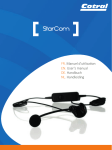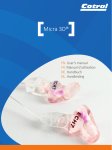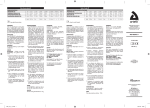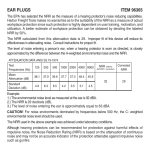Download InstaMold User Guide
Transcript
User Guide for full shell and CIC earplugs Definition of Terms An ear plug may be defined as a standalone item which plugs the ear canal to block out noise or water. Our ear molds are re-usable. An ear mold can connect to an electronic device such as a radio receiver, sound enhancer or hearing aid. The ear mold component of your specialized hearing system is a key factor in realizing its optimal performance. Your new ear mold or earplug has been professionally crafted from your ear impression, assuring you of an effective and comfortable fit. Every human ear is unique. Just as with eyeglasses, you may have to allow a little time to adjust to your new ear mold or ear plug. Should circumstances require, our policy is that ear mold modifications or replacements will be made during your adjustment period (30 days) without charge. If you are using your protections for the 1st time, wear your protections gradually Start with 2 hours at the end of a shift for the 1st day*, Increase wearing time little by little. * your usual protections should be worn for the remainder of your working hours. A protector must be inserted in a quiet place. You need to protect yourself 100% of the time from exposure to noise. Insertion of the ear mold or earplug Each ear mold or ear plug is custom-crafted to fit the contours of a particular ear. This results in a secure, inconspicuous fit. Be sure to insert the ear mold or ear plug into the ear for which it was made. They are usually marked with a dot: Red is right and blue is left. If there is only one mark, it will indicate the left ear with a blue mark. If your ear mold is connected to a hearing aid or similar device, turn it off or set the volume control to its lowest level. 1. Hold the ear mold or ear plug between the thumb and forefinger. To Insert: Properly Inserted: Insert the mold or plug by placing its canal portion into your ear canal. Gently twist it between your fingers to insert it in your ear. To assure a snug fit, pull the earlobe outward with your thumb and forefinger while pressing the ear mold or ear plug inward with the forefinger of the other hand. Seat the top of the protector under the fold of the ear. 2. After you have secured the ear mold in place, adjust the volume to a comfortable level. If you hear a whistling or squealing sound, try to readjust the ear- mold. If the whistling persists, check with your provider. 3. It is necessary to have a tight and comfortable fit to assure the best protection Removal of the ear mold or earplug To remove, gently pull the ear until the seal is broken. Hold the ear mold or ear plug between the thumb and forefinger. Rotate the ear mold or ear plug slightly towards the front of the head while slowly pulling it out of the ear. To remove: Use of the “WAX LOOP“ This device is designed for trouble-free removal of wax from the ear canal portion of your ear mold and vent. You should insert the loop, at a slight angle, just into the opening of the canal to gently lift wax out. Should your ear mold have a vent hole located along the sound channel, this opening should also be cleaned with the Wax Loop. The loop is only used if the plug has a vent hole. Use the brush only on solid molds. Care and Maintenance of your ear mold earplug Following these suggestions, you should realize optimal performance from your ear mold or ear plug. 1. Inspect the ear mold or noise blocker daily for earwax, which may be obstructing the sound, bore or vent. (See instructions, for using your Wax Loop.)You can even wash your ear molds (without electronic parts) with warm water and mild hand soap. Do not use harsh detergents or cleaning compounds. 2. Wipe the entire ear mold or ear plug clean each day with a soft tissue to eliminate any buildup of residue or wax. 3. Periodically, a small amount of moisture may accumulate in the ear mold or clear plastic tubing. This could completely block the sound coming from your hearing aid. Your hearing provider will be able to offer solutions for this problem. 4. If the clear plastic tubing that connects the ear mold to your hearing aid becomes cracked, damaged or starts to become hard and discolored, it should be replaced by your hearing provider. 5. After you have secured the ear mold in place, adjust the volume to a comfortable level. If you hear a whistling or squealing sound, try to readjust the ear mold. If the whistling persists, check with your provider. 6. Store in your carrying case to prevent loss, keep them clean and ready for use. Replacement of your ear mold or earplug For the following reasons, return to your provider for a new ear mold/ ear plug or a replacement: 1. If you have a marked change in body weight, your ear mold or ear plug may need to be replaced to accommodate this physical change. 2. Many times, children’s molds and plugs may need recoating or replacing to allow for rapid growth rate. 3. Physical adaptation of the ear tissue to the ear mold or ear plug may occur over time, requiring a new fitting to secure an inadequate seal. 4. Replacement may be necessary due to damage or discoloration over time. 5. After the ear molds lifecycle (4 – 5 years) we recommend that you replace your hearing protection. Warning: These Earplugs should not be used if there is the risk that the connecting cord could be caught up during use. Introduce, insert and maintain the protections according to the instructions contained in this guide. Constantly wear protections in noisy surroundings. If the recommendations given above are not followed, the protection provided by the molded ear plug will be substantially impaired. This product may be adversely affected by certain chemical substances. Further information should be sought from the manufacturer. Your hearing protectors are CE certified according to standard EN 352-2: 2002. Notified Body having performed the CE type test: CRITT SPORTS LOISIRS, ZA du Sanital, 21 rue Albert Einstein, 86100 Châtellerault, France. dientified under no. 0501. 2pluxx GmbH obere Bahnhofstr. 54 8640 Rapperswil Switzerland Tel : +41 55 210 8000 www.2pluxx.ch Insta Mold solid full shell Mean Attenuation (dB) Standard Deviation (dB) Assumed Protection (dB) EN 352 Frequency (Hz) 63 26,5 8,0 18,5 125 27,9 5,6 22,3 250 26,2 5,1 21,1 500 1000 2000 28,7 28,8 32,9 4,3 4,3 3,4 24,4 24,5 29,5 4000 40,6 5,0 35,6 8000 37,9 6,1 31,8 H (dB) 30,0 M (dB) 25,6 L (dB) 23,5 SNR (dB) 29,0 Insta Mold filtered full shell Mean Attenuation (dB) Standard Deviation (dB) Assumed Protection (dB) Frequency (Hz) 63 13,4 6,5 6,9 125 13,3 6,0 7,3 250 14,0 4,7 9,3 500 1000 2000 18,8 24,6 29,5 3,8 3,5 5,1 15,0 21,1 24,4 4000 37,4 4,6 32,8 8000 31,0 7,2 23,8 H (dB) 25,2 M (dB) 18,2 L (dB) 12,1 SNR (dB) 21,3 Insta Mold acoustic filtered CIC Mean Attenuation (dB) Standard Deviation (dB) Assumed Protection (dB) Frequency (Hz) 63 125 11,9 11,5 5,8 4,2 6,1 7,3 250 12,7 4,1 8,6 500 1000 2000 18,3 24,1 30,5 3,7 4,8 3,5 14,6 19,3 27,0 4000 35,7 3,5 32,3 8000 26,6 6,9 19,8 H (dB) 24,3 M (dB) 17,4 L (dB) 11,7 SNR (dB) 20,4 LabPluxx DFC full shell Mean Attenuation (dB) Standard Deviation (dB) Assumed Protection (dB) Frequency (Hz) 63 23,3 6,1 17,2 125 22,5 5,7 16,8 250 21,4 5,2 16,2 500 1000 2000 23,3 23,3 30,8 4,4 5,4 4,1 18,8 17,9 26,7 4000 35,1 3,5 31,6 8000 35,0 4,5 30,5 H (dB) 25,4 M (dB) 19,7 L (dB) 18,1 SNR (dB) 23,6 LabPluxx acoustic filtered CIC Mean Attenuation (dB) Standard Deviation (dB) Assumed Protection (dB) Frequency (Hz) 63 125 19,4 19,7 8,8 7,3 10,7 12,4 250 18,7 7,0 11,7 500 1000 2000 21,9 24,4 29,8 5,7 4,5 3,4 16,2 19,9 26,4 4000 35,8 3,6 32,2 8000 32,4 5,3 27,1 H (dB) 26,1 M (dB) 19,2 L (dB) 14,9 SNR (dB) 22,7 Acrylixx acoustic filtered CIC Mean Attenuation (dB) Standard Deviation (dB) Assumed Protection (dB) Frequency (Hz) 63 15.6 7.1 8.5 125 17.6 9.2 8.4 250 16.8 6.8 10 H(dB) 25.9 M(dB) 17.7 63 24,6 6,7 125 23,4 4,4 250 19,7 3,5 500 21,1 3,7 17,9 19,0 16,2 17,4 HearDefenders-DF Mean Attenuation (dB) Standard Deviation (dB) Assumed Protection (dB) 500 20.5 5.9 14.7 1000 24.2 5.8 18.5 2000 33.2 4.9 28.3 L(dB) 12.7 4000 36.7 3.4 33.3 8000 35.5 7.5 27.9 SNR (dB) 21.3 Frequency (Hz) H (dB): 23,8 M (dB): 19,2 1000 22,7 4,7 2000 29,2 4,4 18,0 24,8 L (dB): 17,9 4000 32,8 6,9 8000 32,9 8,0 25,9 24,9 SNR (dB): 22,7












